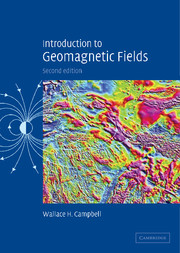Book contents
- Frontmatter
- Contents
- Preface
- Acknowledgements
- 1 The Earth's main field
- 2 Quiet-time field variations and dynamo currents
- 3 Solar–terrestrial activity
- 4 Measurement methods
- 5 Applications
- Appendix A Mathematical topics
- Appendix B Geomagnetic organizations, services, and bibliography
- Appendix C Utility programs for geomagnetic fields
- References
- Index
2 - Quiet-time field variations and dynamo currents
Published online by Cambridge University Press: 05 June 2012
- Frontmatter
- Contents
- Preface
- Acknowledgements
- 1 The Earth's main field
- 2 Quiet-time field variations and dynamo currents
- 3 Solar–terrestrial activity
- 4 Measurement methods
- 5 Applications
- Appendix A Mathematical topics
- Appendix B Geomagnetic organizations, services, and bibliography
- Appendix C Utility programs for geomagnetic fields
- References
- Index
Summary
Introduction
It is the nature of geomagnetic fields to not divulge their sources simply. The observatory magnetometers (Earth-field measuring devices described in Chapter 5) respond to all the fields reaching the local environment, add them together, and limit recording only by the frequency response designed into the instruments. A large part of research in geomagnetism concerns the dissection of field variation recordings to isolate the individual contributing sources, discover the physical processes that cause these currents, and thereby understand another feature of our global environment. Occasionally, a newly revealed feature becomes immediately important and useful to society's needs; usually, its utility is discovered only after many years. One of the first field sources to be discovered (Stewart, 1883; Schuster, 1889, 1908) was a current driven by tidal forces and winds in a conducting region above the Earth that was subsequently named the ionosphere. Such currents are indicated by a recurring field pattern on quiet-time daily recordings. The accurate determination of quiet-day field variation now finds utility in improvement of satellite main-field modeling, in profiling the Earth's electric conductivity, and in establishment of baselines from which magnetospheric disturbances are quantified.
The purpose of this chapter is to explain the origin and behavior of the regularly recurring field variations that have periods of a day or less. Because the principal source for these currents lies in a naturally ionized layer above the Earth, we will examine the basic features of this ionosphere.
- Type
- Chapter
- Information
- Introduction to Geomagnetic Fields , pp. 67 - 110Publisher: Cambridge University PressPrint publication year: 2003



